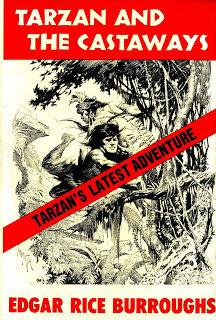Frazetta: The Lost "Castaways" Cover
The powerful Tarzan drawing that baffled me for years.
Back when I was a teen and voraciously tracking down all the Frazetta art I could, I bought The Magic of Frazetta by mail-order. Within its black-and-white pages, I discovered many hitherto-unseen (by me, at least) works by the mighty Frazetta. One of them really stood out. It was a pen-and-ink drawing of a lion charging at the viewer with Tarzan on its back, stabbing away. Powerful, dynamic stuff.
Now, I studied to be an artist as a preteen and up through high school. I’ve usually been able to figure out when an artist did a particular piece. At least, that’s—nearly—always been the case with Frazetta, Jones, Wrightson, Whelan and several others. So, when I was confronted with this particular illo, it presented a conundrum. It certainly looked like it was done in what I call Frazetta’s “Canaveral style”. That is, the style he used when illustrating Tarzan and the Castaways, which I discussed here. Frank, to my knowledge, never really used that style before—when he did work for Ace Books—or later—when he was working for Lancer Books and others. It certainly didn’t look like his later work in the ‘70s for the Science Fiction Book Club and others.
So, where did it come from? It absolutely didn’t look like a quick sketch, which Frazetta was known to send to Amra and other fanzines during the ‘60s. It looked like Frank had spent some time on this one. This “orphan” illo remained a mystery to me for decades. I would sometimes see it on the Net included in galleries of art supposedly from Tarzan and the Castaways, but, having been quite familiar with that edition since I was seven years old, I knew it wasn’t in that edition or any other subsequent edition.
Fast-forward to May of 2020. I’m doing research on Frazetta’s art for Tarzan and the Castaways and I go see what the extremely knowledgeable folks over at the ERB-zine website have to say about this edition. I find all I really need to know for my post near the top of that particular entry. However, scrolling way down, I found this:
That solved the mystery right there. The artwork I had been wondering about for decades was the unused art for the cover of Tarzan and the Castaways. Not only did ERB-zine provide the original drawing, they also posted the mock-up cover—apparently lettered by Frazetta himself. Frank, who was a J. Allen St. John fan since childhood, even used the “dagger” Tarzan logo created by St. John for the original cover of Tarzan the Untamed.
Looking a little deeper into the ERB-zine archives, I discovered that the unused art—apparently—first saw print in one of the early issues of ERB-dom, the Hugo-winning fanzine edited and published by legendary ERB/pulp scholar, Caz Cazedessus.
Why did Canaveral Press reject one cover and accept the other? I think there are two likely reasons. One is that there isn’t a scene—in any of the three stories in “Castaways”—which matches up with Frank’s drawing. It doesn’t illustrate any of the tales, albeit, it’s a powerful work of art. The second reason is that the drawing that was accepted is just as good if not better, it illustrates the story named in the book title and—despite the censorious red bar across the cover hiding Itzl Cha’s nether regions—it’s much sexier.
Personally, I think the editors at Canaveral made the right call. I just wish that Frazetta’s “orphan” drawing had been able to find a home. It wouldn’t be that hard to do an entire set of Tarzans using “orphan” Frazetta illos like this as covers, along with the “official” Tarzan art that was used by Ace in the ‘60s and ‘70s—though I’m sure there might be legal hassles. Some art might need colorized, a la Phil Normand’s execellent job on his repro cover for “Castaways”, but I’m cool with that. Frank—a Tarzan fan since childhood—did a fair amount of Tarzan art that never made it into/onto an Ace paperback or a Canaveral edition. The 1970s cover for The Land of Hidden Men very likely was intended as a Tarzan painting…but that’s a story for another post.



